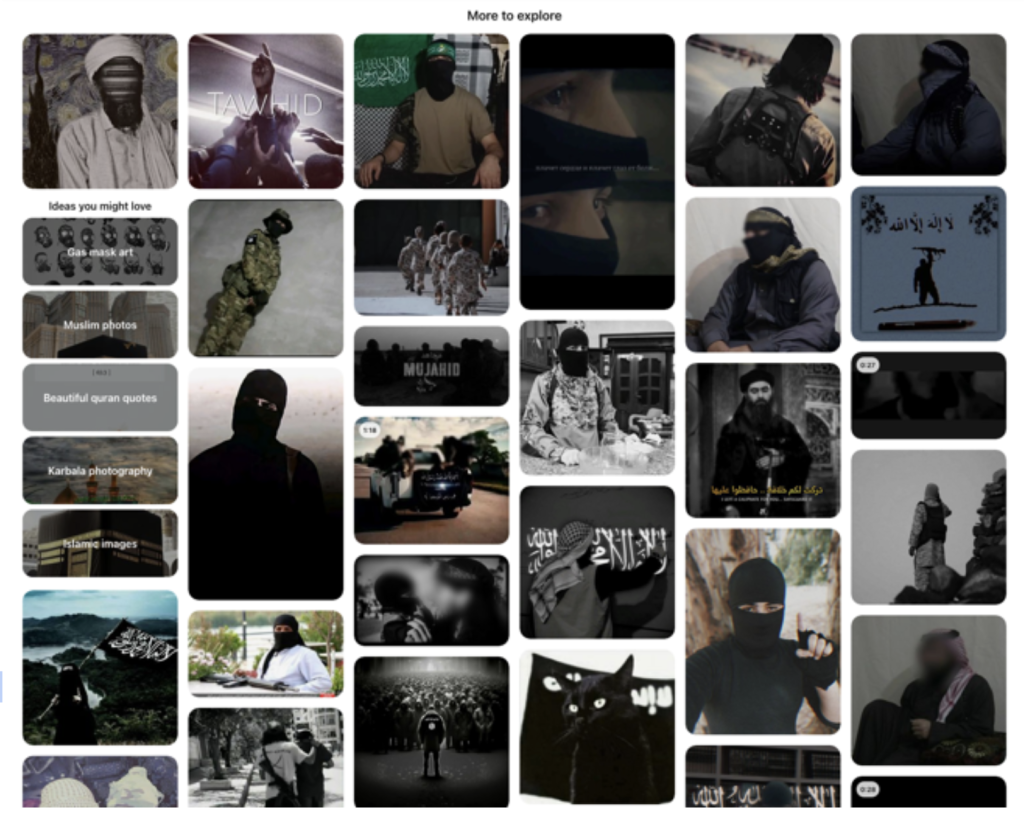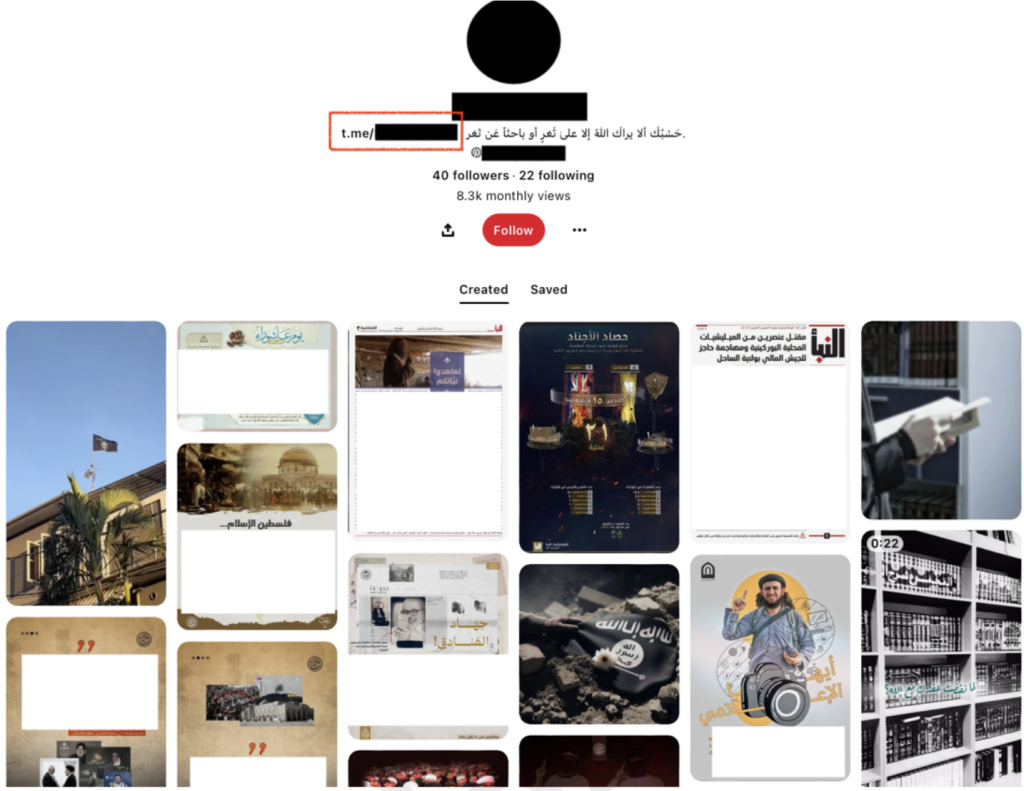Introduction
This is the second part of a two-part examination of pro-IS accounts and content on Pinterest. The previous Insight focused on general observations by reviewing the types of content IS supporters post, how the algorithm assists users in finding more IS-themed Pins, and content evasion strategies users employ to disseminate propaganda and evade content moderation efforts. This follow-up Insight provides a more granular review of pro-IS accounts and their platform-specific behaviours by presenting data findings drawn from a sample of 30 pro-IS accounts. The first section explains how the accounts in the data sample were initially identified, followed by a data breakdown of the main posting languages used by the accounts, received monthly views, and estimated account longevity. The conclusion discusses how various factors, such as posting patterns, content evasion strategies, and monthly views, intertwine and offers policy recommendations.
Navigating to IS Pinterest Content
On 26 July 2024 I created a new account on Pinterest to begin with a fresh feed. My first search included three keywords in various languages, which led me to distinctly pro-IS content. As shown by the screenshots below, not all Pin results were IS-related, but it was still enough of a lead, which allowed me to tunnel more directly into the pro-IS side of the platform. The keyword searches directed the algorithm to create a specialised home feed with pro-IS Pins that now appear automatically. After clicking on an IS Pin from this feed, the “more to explore” section provided the following suggestions (figure 1):

Figure 1: the “more to explore” section displaying distinctly jihadist recommendations.
Although some search results led to images of IS posted by news organisations, most are distinctly pro-IS. Navigating to these results took about 10 minutes. Although search terms in some languages produced a ‘violation of community guidelines’ notice, other languages easily bypassed the restriction.
A Sample of IS-Supporter Pinterest Accounts
Over a three-day period from 27-29 July, I collected and reviewed information from 30 Pinterest accounts posting IS content. During the data collection process, I identified accounts in the sample by selecting pro-IS Pins that appeared after my keyword searches and examining the original poster’s account page. I continued to identify more accounts with the assistance of the algorithm (using the algorithm as part of a snowballing approach) which suggested similar Pins to content I was already viewing until I reached a sample of 30. In order to keep criteria consistent, the sample of accounts had to meet the following requirements: a history of posting pro-IS Pins under the “created” tab (even if IS Pins were not in the majority). It is common for IS supporters to simply “save” Pins, but for the purposes of this data sample, it was important to establish that the data was gathered from individuals who actively engaged in promoting IS content. The criteria also refined the sample to accounts that more directly seek to share propaganda and, therefore, blatantly violate the community guidelines of Pinterest.
Data Breakdown
Interesting patterns emerged from the sample of 30 accounts:
- For all accounts where the “monthly views” number was viewable, they collectively received a total of 5.9 million views.
- One account received 2.6 million monthly views, and its “created” tab included multiple Pins of a French IS executioner pointing a knife at the camera.
- 12 accounts did not display the “monthly views” number, meaning that the estimate is certainly on the lower side.
- The accounts collectively had a total of 34.8K followers.
- The accounts collectively followed 1 060 other Pinterest accounts.
- 83.33% of accounts did not use an IS image as their profile photo.
- 73.34% of accounts had a posting history where a majority of their “created” Pins were unrelated to IS. Instead, they sprinkled in IS Pins among content that did not violate community guidelines, such as general religious quotes, photos of food and fashion, or nature.
Accounts created Pins in various languages which are broken down into the following:
- Arabic: 10
- English: 6
- Russian: 6
- Turkish: 5
- Bahasa-Indonesia: 2
- Amharic: 1
- Portuguese: 1
*One account posted content in both English and Bahasa-Indonesia – it is counted twice under both the Bahasa-Indonesia category and English.
- Account longevity was harder to measure, but an estimate was created by viewing comments on older Pins and/or viewing when the account posted its oldest image board collection. Although these methods are not exact, they helped provide a general timeline.
- 63.33% of accounts were created at least 6-12 months ago.
- 23.33% of accounts were created at least 1-5 months ago.
- 13.33% of accounts did not have enough information to create an estimate.
Conclusion
This preliminary examination of pro-IS Pinterest accounts provided deeper insights into account behaviour on the platform. As demonstrated by the data, accounts posting IS content are able to reach a much larger audience than their follower, and following lists might otherwise suggest. Mixing IS Pins in with content that does not violate Pinterest’s community guidelines appears to be a successful method of not only avoiding an account ban but also attracting more monthly views through non-extremist images and hashtags. It is important to state that this does not mean the IS content itself is necessarily receiving that wide a viewership. However, it indicates that the account attracts “greater engagement and potential for driving website traffic…” and with that comes an increased probability that the IS content also receives more views.
This matters because both IS and its wider online supporter base value the role virtual environments play in disseminating content, connecting like-minded individuals, recruiting, archiving propaganda, and growing social networks. Pro-IS supporters also see their ability to successfully carve out a space on social media as a victory and a testament to their savviness on the virtual battlefield against platforms that have spent tremendous time and money to remove them. Finally, the ability of supporters to maintain accounts on both open and more closed platforms allows for adaptive and flexible strategies when facing content moderation efforts. As demonstrated by the example screenshot below, which includes a redacted Telegram link [t.me/], pro-IS accounts often promote their cross-platform presence by directly linking to accounts and channels on other platforms (figure 2):

Figure 2: A pro-IS account promoting its cross-platform presence by directly linking to accounts on other platforms.
Stemming terrorist exploitation of the internet through big data approaches is crucial, but it can be further supplemented by granular deep dives where researchers imitate the same steps an IS supporter (in this case) would have to go through to find such content. Not conducting deep-dive examinations risks, firstly, overlooking platform-specific strategies extremists develop in response to content moderation efforts and, secondly, identifying other areas of weakness, such as content moderation not catching pro-IS posts in overlooked languages.
On a final note, policymakers should consider the following when addressing pro-IS Pinterest accounts:
- Supporters frequently attempt to bury pro-IS content among normal content. Reviewing accounts on a more granular level and seeing if they have a history of actively ‘creating’ an ‘X’ number [it would be up to the platform to set the number] of IS Pins could act as a threshold that would justify an account ban even if a majority of Pins are innocuous.
- Accounts that publicly save a notable number of IS Pins could be put on a review list to see if a ban is merited, depending on further examination.
- Continue cross-platform collaborations: Pinterest should note when pro-IS accounts share links to other platforms in comment sections and coordinate with the linked platform. Vice-versa would also be helpful—for example, Meta letting Pinterest know when IS supporters share account links to specific Pins or Pinterest accounts.
- Identifying content moderation weak points in various languages.
Content moderation efforts are not a fix-all solution, but stemming the amount of publicly available content and disrupting pro-IS supporters’ ability to maintain an ongoing presence on more open platforms would ideally make it more difficult for them to establish stability.
